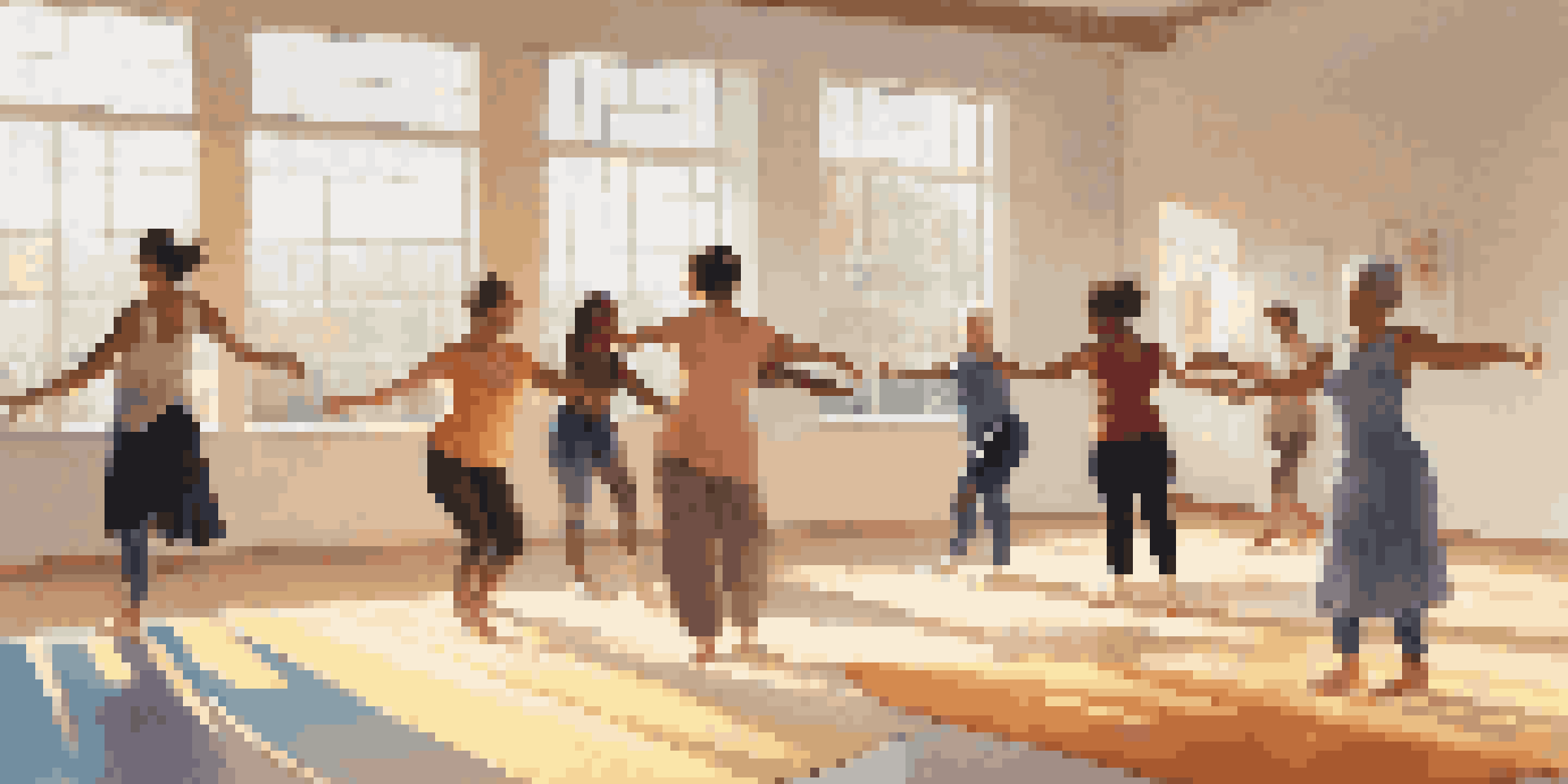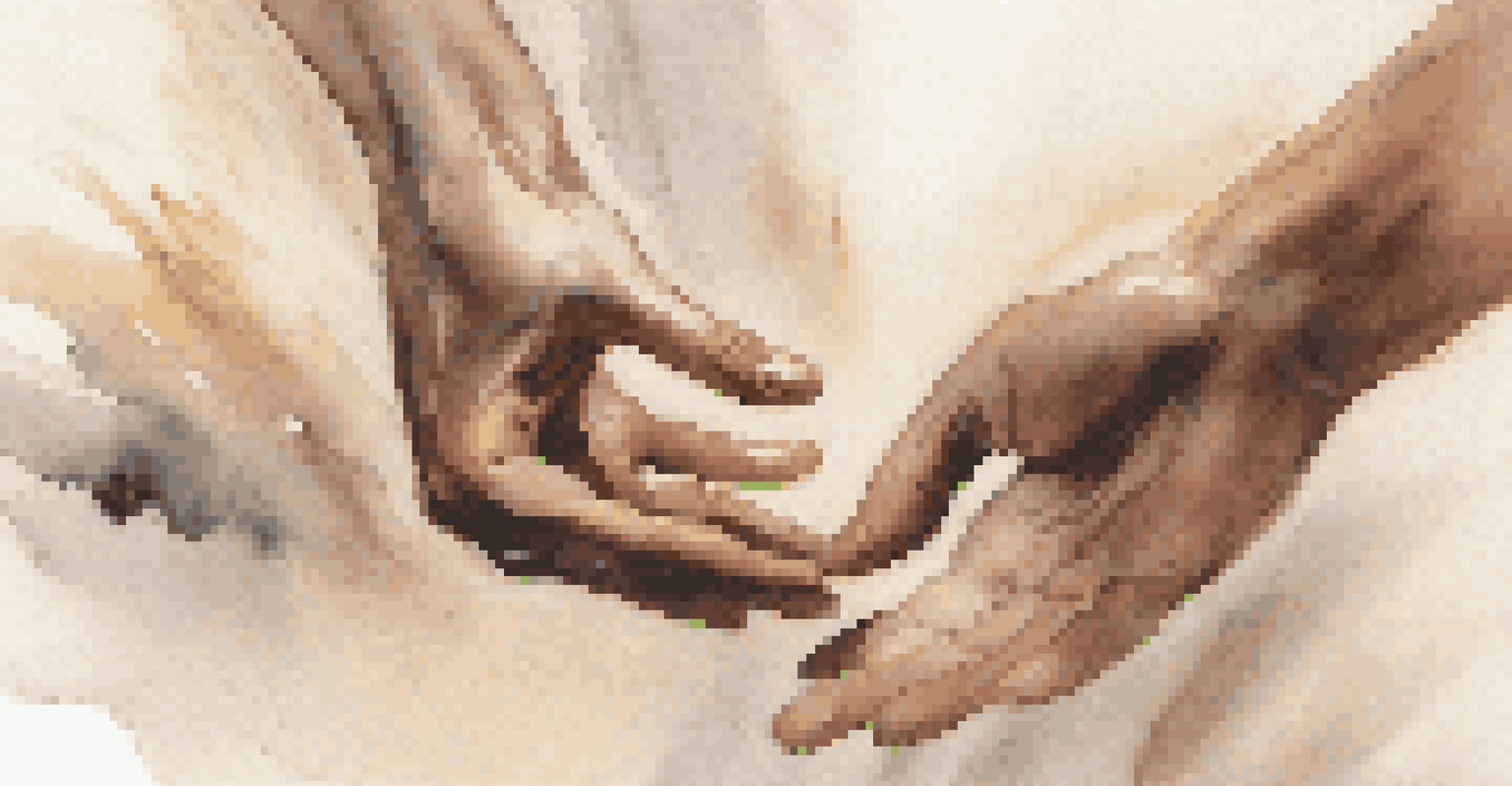Dance Therapy: Healing through Movement and Community Connection

Understanding Dance Therapy: What Is It Really?
Dance therapy, also known as dance/movement therapy (DMT), is a therapeutic approach that uses movement to promote emotional, cognitive, and physical integration. It's based on the idea that body and mind are interconnected, and movement can express feelings that words cannot. This form of therapy isn’t just about learning dance steps; it's about exploring how movement can lead to healing.
Dance is the hidden language of the soul.
In a dance therapy session, participants engage in spontaneous dance and movement activities designed to help them connect with their emotions and experiences. A trained therapist guides the session, encouraging self-expression and providing a safe space for exploration. This process allows individuals to express feelings of joy, sadness, or anger through their bodies, fostering a deeper understanding of themselves.
One key aspect of dance therapy is its adaptability. It welcomes people of all ages and abilities, embracing the uniqueness of each individual's movement. Whether someone is a seasoned dancer or has never moved to music before, dance therapy creates an inclusive environment where everyone can participate and benefit.
The Science Behind Dance Therapy: How It Works
Research supports the effectiveness of dance therapy in reducing symptoms of anxiety, depression, and trauma. When we move, our brains release endorphins, which are natural feel-good chemicals. This biological response can elevate mood and foster a sense of well-being, making dance therapy a powerful tool in the healing process.

Furthermore, dance therapy encourages mindfulness, helping individuals become more aware of their bodies and emotions. This heightened awareness can lead to better emotional regulation and coping strategies, essential for navigating life's challenges. For instance, someone dealing with stress may find that through movement, they can release pent-up emotions and gain clarity.
Dance Therapy Promotes Healing
Through movement, dance therapy fosters emotional expression and healing, allowing individuals to connect with their feelings in a profound way.
Additionally, the communal aspect of dance therapy enhances its benefits. Participating in group sessions can create a sense of belonging and reduce feelings of isolation. As individuals share their movements and stories, they cultivate empathy and connection, further amplifying the healing power of the experience.
Benefits of Dance Therapy: More Than Just Movement
The benefits of dance therapy extend far beyond physical movement. Participants often report increased self-esteem and improved body image, as they learn to appreciate their bodies for their abilities rather than their limitations. This shift in perspective can empower individuals, helping them embrace their uniqueness.
Movement is a medicine for creating change in a person's physical, emotional, and mental states.
Moreover, dance therapy can enhance social skills, particularly in group settings where participants interact and collaborate. This is especially beneficial for children and adolescents who may struggle with social interactions. Learning to communicate through movement can translate into improved verbal communication skills and stronger relationships outside of therapy.
Lastly, dance therapy can serve as a creative outlet for self-expression, allowing individuals to articulate feelings that may be difficult to express verbally. This creativity not only aids in personal exploration but can also lead to a deeper sense of fulfillment and joy in everyday life.
Who Can Benefit from Dance Therapy?
Dance therapy is not just for those who are experiencing trauma or mental health challenges; it can benefit a wide range of individuals. For example, children with autism spectrum disorder often find joy and connection through movement. Dance therapy provides a nonverbal medium for them to express themselves and connect with others.
Adults dealing with chronic illness or pain may also find relief through dance therapy. Movement can help alleviate physical tension and foster a sense of empowerment, making individuals feel more in control of their bodies. This holistic approach often leads to improved physical health and emotional resilience.
Accessible for Everyone
Dance therapy is inclusive, benefiting individuals of all ages and abilities, from children with autism to adults facing chronic pain.
Even those without specific issues can benefit from dance therapy. It offers a joyful way to engage with one’s body, promote physical fitness, and enhance overall well-being. In a world where stress is rampant, dance therapy can be a refreshing and enjoyable escape.
Dance Therapy Techniques: Exploring the Medium
Dance therapy employs a variety of techniques to foster expression and healing. Some sessions may include improvisational movement, where participants are encouraged to move freely without a set structure. This spontaneity allows individuals to connect deeply with their emotions and explore their inner landscape.
Group activities, such as mirroring dances, can strengthen connections among participants. In this exercise, one person moves while others replicate their movements, fostering empathy and understanding. This not only builds trust within the group but can also enhance self-awareness as individuals notice how they relate to others.
Additionally, storytelling through dance is a powerful technique used in dance therapy. Participants might create a dance that tells a personal story, helping them process experiences and emotions. This form of creative expression can be cathartic and provide a profound sense of release and healing.
Finding a Dance Therapist: What to Look For
When considering dance therapy, finding the right therapist is crucial. Look for someone who is a licensed dance/movement therapist and has the appropriate training and credentials. This ensures that they have the necessary skills to guide you safely through the therapeutic process.
It's also essential to find a therapist whose approach resonates with you. Some therapists may focus more on the emotional aspects of dance, while others might emphasize physical movement and wellness. Consider having an initial conversation to discuss their methods and see if their style aligns with your needs.
Growing Recognition and Use
As awareness of mental health expands, dance therapy is increasingly integrated into healthcare practices, enhancing its accessibility and legitimacy.
Lastly, trust your instincts. A strong therapeutic relationship is built on trust and safety, so it’s vital to feel comfortable with your therapist. Remember, this journey is about you and your healing, and finding the right fit can make all the difference.
The Future of Dance Therapy: A Growing Field
As awareness of mental health and holistic healing continues to grow, dance therapy is gaining recognition as a vital therapeutic option. Many healthcare providers are incorporating dance therapy into treatment plans, acknowledging its effectiveness in various settings, from hospitals to community centers.
Moreover, the rise of virtual dance therapy sessions has expanded access for individuals who may not have local services. This shift allows people from diverse backgrounds and locations to experience the benefits of dance therapy, breaking down barriers to mental health support.

Looking ahead, the future of dance therapy seems bright. As research continues to validate its benefits, we can expect to see more integration into mainstream healthcare practices, making it more accessible and recognized as a legitimate form of therapy for those seeking healing through movement.